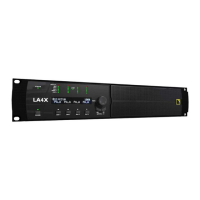Operation
ENCLOSURE CHECK
ENCLOSURE CHECK is a preliminary diagnosis tool for the loudspeaker enclosures connected to the amplied controller.
Refer to the ENCLOSURE CHECK technical bulletin for the full procedure.
OPTIONS
The OPTIONS menu gives access to the amplied controller general settings:
— IP address
— delay unit (ms, meters, feet or samples)
— LCD screen contrast
— LED and screen backlight mode
— reset to default factory settings
‾NETWORK ADDRESS ‼※
192 . 168 . 1 . 100
‽DELAY UNIT ‼※
ms
‽SCREEN CONTRAST ‼※
80%
‽LED & BACKLIGHT MODE ‼※
NORMAL
‿RESET TO FACTORY ‼※
DEFAULT SETTINGS?
‿OPTIONS ‼※
OK
NETWORK ADDRESS
Remote control of amplied controllers requires setting up a private local area Ethernet network to interconnect up to 253
units with a single control computer (and possible additional devices such as Ethernet switches). This Ethernet network is
called L-NET and uses a proprietary communication protocol based on TCP/IPv4 called L-COM. The IP addresses on the
units are class C addresses and must be set manually. The default subnet for L-NET is 192.168.1.0.
IP address setting
Each unit must be given an IP address that is unique within the local area network.
It is suggested to give the units consecutive IP addresses from 192.168.1.1 to 192.168.1.253, and to set the
control computer to 192.168.1.254.
An IP address is a unique identier for a network device on a given IP network. In IPv4 networking, it is made of
4 bytes. In class C private local area IP subnets, the three rst bytes are the network prex and the last byte is the
device identier on the subnet. Regarding device identiers, two numbers are reserved: 0 to designate the subnet,
and 255 to communicate with all devices of the subnet (the IP broadcast address).
47 LA4X user manual (EN) version 9.1

